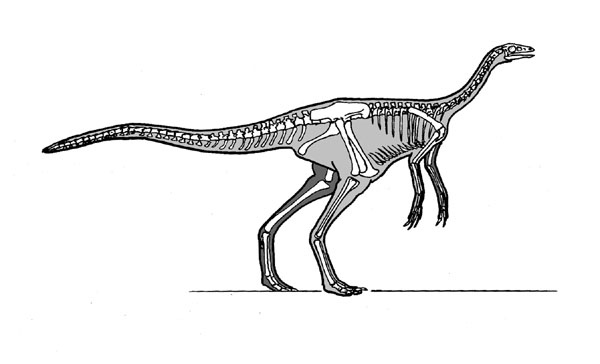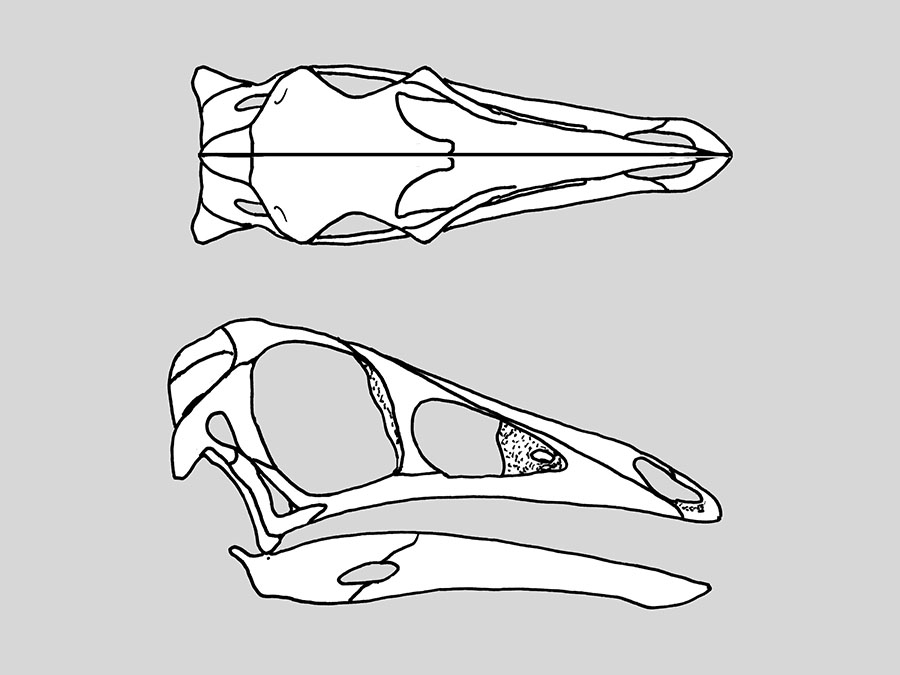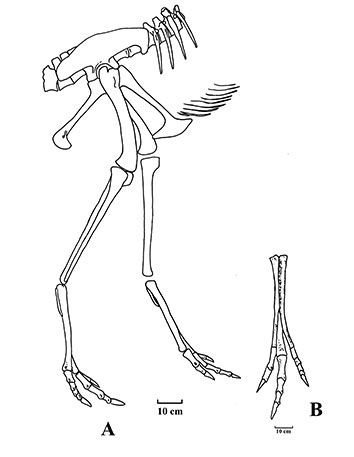Holotype: ROM 797
Locality: East side of the Red Deer River 2 miles below Bleriot Ferry, Wheatland County, Alberta Province, Canada.
Horizon: Horseshoe Canyon Formation, Edmonton Group.
Note: Formerly Member A of Edmonton Formation.
Biostratigraphy:
Age: Edmontonian age, lower Maastrichtian Stage, Upper Senonian subepoch, Upper Gulf Epoch, Late Cretaceous.
Material: Sacrum, pelvic girdle, 2 complete hind limbs, 4 proximal caudal vertebrae attached, 7 scattered distal caudal vertebrae, and 2 fragmentary ribs.
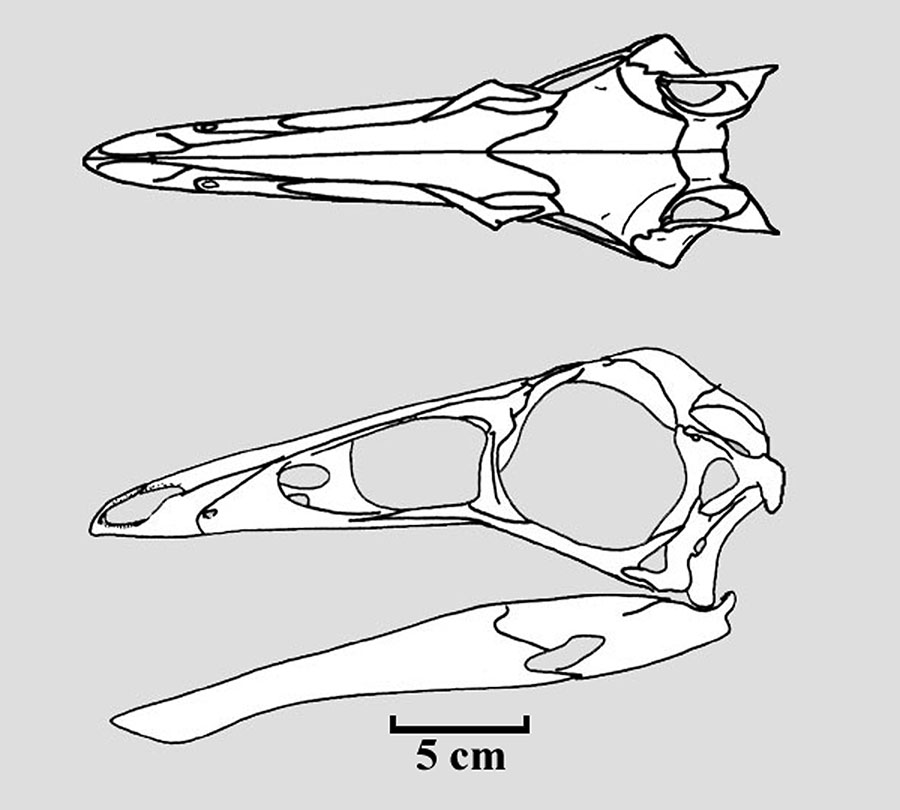
Dromiceiomimus brevitertius (after RUSSELL, 1972), Holotype: ROM 797.
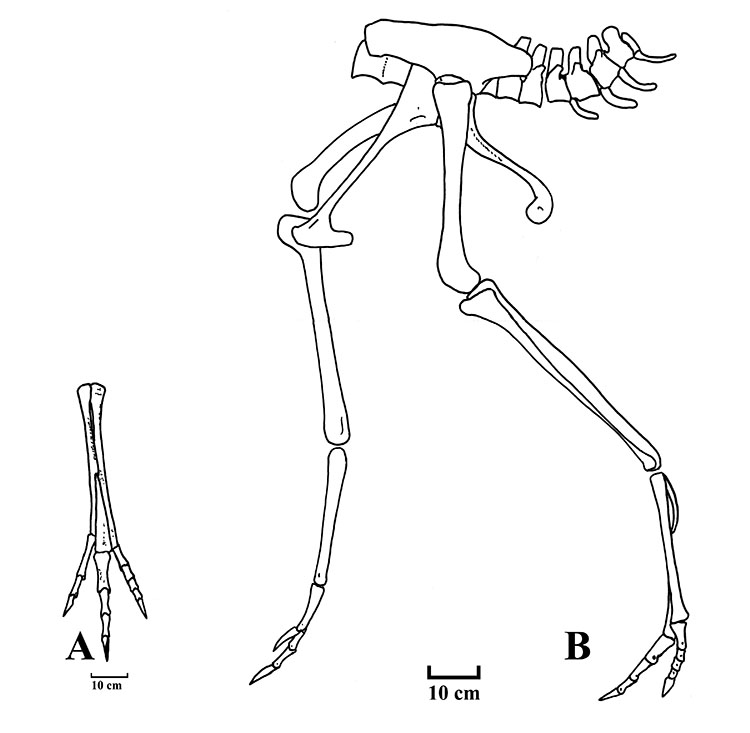
After Parks, 1926.

Caudal vertebra after Parks, 1926.
Referred material:
Locality: ?Section 19, Tp 34, R21, West of 4th m, approximately 9 m above west bank of Red Deer River, Wheatland County, Alberta Province, Canada.
Horizon: Horseshoe Canyon Formation, Edmonton Group.
Note: Formerly Member B of Edmonton Formation.Biostratigraphy:
Age: Edmontonian age, lower Maastrichtian Stage, Upper Senonian subepoch, Upper Gulf Epoch, Late Cretaceous.
Material:
AMNH 5201: Both humeri, both pubes and ischia, left femur, tibiae-fibulae, metatarsal fragments, phalangeal elements of left pes.
Locality: Dry Island Buffalo Jump Provincial Park, Northeast quarter of sec. 28, tp 34, R21, West of 4th M, 55 m above east bank of Red Deer River, Wheatland County, Alberta Province, Canada.Horizon: Horseshoe Canyon Formation, Edmonton Group.
Note: Formerly Member B of Edmonton Formation.Biostratigraphy:
Age: Edmontonian age, lower Maastrichtian Stage, Upper Senonian subepoch, Upper Gulf Epoch, Late Cretaceous.
Material:
NMC 12068: Sacrum and adjacent dorsal vertebrae, tail, left ilium, both pubes and ischia, both hind limbs.
NMC 12069: Proximal and distal ends of tail, distal end of both pubes and ischia, left femur, both tibiae-fibulae and feet.
NMC 12070: Distal ends of both tibiae, both metatarsi, pedal phalanges.
Note: Possibly a new genus (CULLEN, RYAN, SCHRÖDER-ADAMS, CURRIE & KOBAYASHI, 2013)
Locality: Sec. 28, tp 31, R21, west of 4th m, approximately 44 m above west bank of Red Deer River, Wheatland County, Alberta Province, Canada.Horizon: Horseshoe Canyon Formation, Edmonton Group.
Note: Formerly Member B of Edmonton Formation.Biostratigraphy:
Age: Edmontonian age, lower Maastrichtian Stage, Upper Senonian subepoch, Upper Gulf Epoch, Late Cretaceous.
Material:
NMC 12228: Posterodorsal region of skull, left temporal region, braincase, anterior half of left mandible, posterior half of right mandible, incomplete presacral vertebral column, nearly complete tail, left ilium, both pubes and ischia, left femora and tibia-fibula, left metatarsus, 2 pedal phalanges.
= Ornithomimus edmontonensis STERNBERG, 1933
Etymology: In reference to the Edmonton Formation.
= Ornithomimus edmontonianus KUHN, 1965 (sic)
= Ornithomimus edmonticus (lapsus calami) LUCAS, MATEER, HUNT & O’NEIL, 1987
= Ornithomimus edmontonensis (lapsus clamani) BARSBOLD & OSMOLSKA, 1989Holotype: NMC 8632
Locality: Sec. 34, TP 30, R21W, 4th M. approximately 30 m above the west bank of the Red Deer River, Alberta Province, Canada.
Horizon: Horseshoe Canyon Formation, Edmonton Group.
Note: Formerly Member A of the Edmonton Formation.Biostratigraphy:
Age: Edmontonian age, lower Maastrichtian Stage, Upper Senonian subepoch, Upper Gulf Epoch, Late Cretaceous.
Material: Fragments of 3 vertebrae, dorsal and abdominal ribs, proximal ends of both coracoids, and humeri, right forelimb, distal end of left femur, both tibiae fibulae, right and part of left pes.
Scapula and coracoid, after Sternberg, 1933.
A) preserved material, B) forearm, after Sternberg, 1933.
Reconstruction of the preserved material.
Referred material:
NORELL, MAKOVICKY, CURRIE, & Ji, 2001
Horizon: Quarry 221, Dinosaur Provincial Park, Newell County, Alberta Province, Canada.
Horizon: Dinosaur Park Formation, upper Belly River Group.
Biostratigraphy:
Age: Judithian age, Middle Campanian Stage, middle Senonian subepoch, upper Gulf Epoch, Late Cretaceous.
Material:
RTMP 95.110.1: Nearly complete skeleton and skull.
Note: Keratinous covering (rhamphotheca).
ZELENITSKY, THERRIEN, ERICKSON, DEBUHR, KOBAYASHI, EBERTH, & HADFIELD, 2012
Locality: Canada.
Horizon: Unit 1, Horseshoe Canyon Formation, Edmonton Group.
Biostratigraphy:
Age: Edmontonian age, lower Maastrichtian Stage, Upper Senonian subepoch, Upper Gulf Epoch, Late Cretaceous.
Material:
RTMP 2009.110.1: Fragmentary skull and skeleton of a juvenile (~1 year old). Note with filaments covering the axial and appendicular skeleton.
RTMP 2008.70.1: Incomplete adtul skeleton missing forelimbs. Note has filamentous feathers preserved as faint 2D carbonized traces along the neck, back and anterior thorax.
Locality: Dinosaur Provincial Park, Newell County, Alberta Province, Canada.
Horizon: Dinosaur Park Formation, upper Belly River Group.
Biostratigraphy:
Age: Judithian age, Middle Campanian Stage, middle Senonian subepoch, upper Gulf Epoch, Late Cretaceous.
Material:
RTMP 1995.110.1: Complete skull and skeleton.
Note: Ulna has marks for feathers?
Ornithomimus edmontonicus (after CUFF & RAYFIELD, 2015), RTMP 1995.110.1.
= Struthiomimus currelli PARKS, 1933
Etymology: In honor of C.T. Currelly, Director of the Royal Ontario Museum of Archaeology.
= Ornithomimus currelli (PARKS, 1933) KUHN, 1965
= Struthiomimus currellii KUHN, 1965 (sic)
Holotype: ROM 5715(ROM 851)
Locality: Red Deer River, 1 mile below Beriot (Munson) ferry at a point on the east side of the river 100 feet above the water level, Wheatland County, Alberta Province, Canada.
Horizon: Horseshoe Canyon Formation, Edmonton Group.
Note: Formerly Member A of Edmonton Formation.
Biostratigraphy:
Age: Edmontonian age, lower Maastrichtian Stage, Upper Senonian subepoch, Upper Gulf Epoch, Late Cretaceous.
Material: Skull and skeleton.
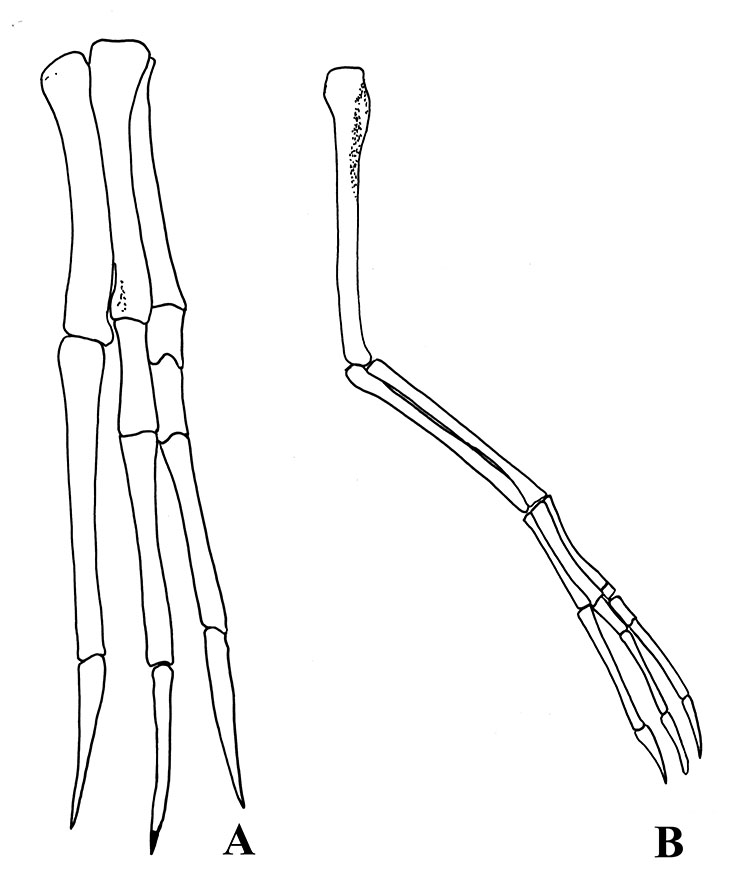
A) manus and B) forearm after Parks, 1933.
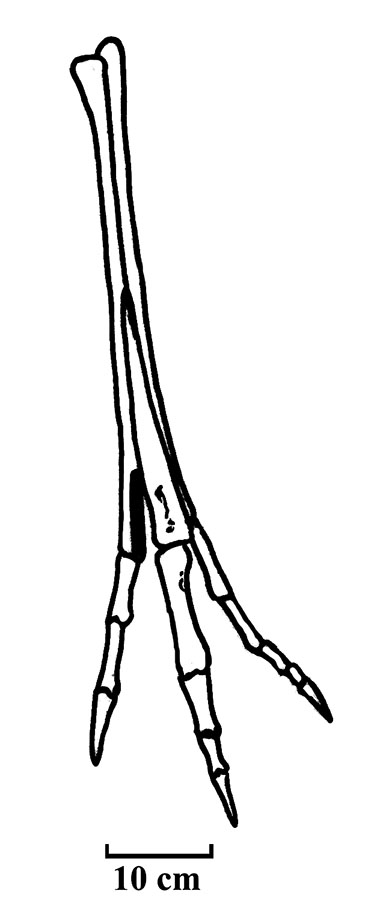
Pes after Parks, 1933.
Reconstruction of the skeleton.
Referred material:
RUSSELL, 1972
Locality: 2.4 km South of Steveville ferry Crossing, Dinosaur Provincial Park, Newell County, Alberta Province, Canada.
Horizon: Dinosaur Park Formation, upper Belly River Group.
Biostratigraphy:
Age: Judithian age, Middle Campanian Stage, middle Senonian subepoch, upper Gulf Epoch, Late Cretaceous.
Material:
NMC 12441: Several dorsal ribs, and caudal vertebrae, left humerus, radii-ulnae, several metacarpals, and phalanges, both femora and tibiae-fibulae.
= Struthiomimus ingens PARKS, 1933
Etymology: Latin, ingens, "massive."
= Dromiceiomimus ingens (PARKS, 1933) RUSSELL, 1972
= Ornithomimus ingens (PARKS, 1933) KUHN, 1965Holotype: ROM 5716 (ROM 852)
Locality: Red Deer River, at a point on the east side, 1/1/2 miles below Beriot (Munson) ferry and 200 feet above the water-level,Wheatland County, Alberta Province, Canada.
Horizon: Horseshoe Canyon Formation, Edmonton Group.
Biostratigraphy:
Age: Edmontonian age, lower Maastrichtian Stage, Upper Senonian subepoch, Upper Gulf Epoch, Late Cretaceous.
Material: Pelvic girdle, one complete hind leg, the other leg lacking the digits, a few dorsal ribs and abdominal ribs.
After Parks, 1933.

